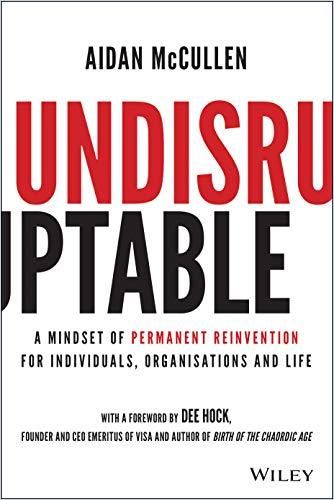“You Almost Fail Your Way Towards Success.”

Aidan, what brought you to the study of innovation in organizations? In your book Undisruptable, you interweave individual growth with organizational growth, so I’m wondering which came first?
The chicken or the egg? I was a professional rugby player. I played professional sports for over a decade. I played for my country, which was a great experience. Firstly, there is a transformation to become that player, because I wasn’t that good as a child. And then, one of the great gifts that happens to sports players is they have to retire early and reinvent themselves. I saw that as a formula for reinvention, that you’re never really finished. You have to keep planting new seeds that will become trees under which you’ll enjoy some shade someday. But you have to do the work early, like that Chinese proverb: “the best time to plant a tree was 20 years ago…” right? Many sports players really struggle to let go of the person they used to be, particularly if they are over-identified with that person.
So, interest in personal change came first?
I was injured in my last couple of years, so I did extensive research on where to go, and what organizations to go into. One of the companies I looked at was Nokia. In November 2007, I picked up Forbes magazine and the cover was about Nokia. It said “1 billion customers – can anyone catch the cellphone king?” And I thought to myself, that looks like a really stable organization to join. But when I looked after Christmas, their stock had gone down precipitously. Within a few years, the mobile phone division was sold to Microsoft, and it was gone. And I wondered what happened there? I became fascinated by that.
What did happen there?
Three or four years before Steve Jobs ever graced the stage in California and introduced the idea of the iPhone, professionals at Nokia had created something like a working iPad with a stylus. They had presented the idea of a touchscreen phone. For a wide range of reasons within the company, cultural and also clinging to profits today, led by a CEO who came in who wanted to just absolutely maximize yield, they ignored their possible future. Then the Apple iPhone comes along. Like any kind of initial disruptive technology, it doesn’t work very well. People forget this about the first iPhones. They were pretty poor phones.
This is a characteristic of most disruptive innovation; the initial products usually don’t work as well as the existing ones, therefore they get dismissed by the legacy incumbent – the dominant player takes their eyes off of it.
In addition, they don’t see that the small initial revenues will move the needle compared to just overserving their best customers. And then that company gets better and better, oftentimes because they initially offer a product to somebody who can’t afford your product. A great example of this is General Motors or Ford in the US when Toyota came in. The initial Toyota car was a crummy car. But what was the alternative for people who couldn’t afford a General Motors or Ford car? Nothing. But then Toyota gets more and more able. They introduce some new products, like the electric vehicle and the Prius, and take off in an entirely new direction. That’s also a cautionary tale because then Toyota got disrupted by Kia. This cycle happens all the time. And if an organization doesn’t have a culture that recognizes this and leadership that recognizes this and is constantly looking for new growth, they are going to be disrupted because this is the speed of change that we’re experiencing today.

Is it safe to say you didn’t end up at Nokia after you retired from rugby?
When I did retire, I joined a media company to set up its digital arm. So I really understood what transformational change was.
What the future was starting to look like?
Yes. And also the really big challenge of letting people know what’s going to happen, how it’s going to happen, how it’s going to affect them. Firstly, they don’t want to know. And secondly, they find every which way to resist that change. Going through that, I understood the difference between transformational change and incremental change. With digitalization, I take a product and digitize it –but it’s still the same product. Incremental change is just a better version of what you already have. A great example is the razor blade. Today we have five blades, next year, six, then seven. Or with the Nokia phone, you’ll add a new feature, but you get to the point where you add so many features you overshoot the needs of the customer. Transformational change is maybe getting into something entirely different.
Take-Aways:
- The first version of disruptive innovation doesn’t usually look like a winner.
- To disrupt yourself and your business, “jump the S-curve” to invest in new growth.
- Don’t forget there is an emotional dimension to change. Head off resistance by including everyone and communicating the overall strategy.
How does the “innovation mindset” play into incremental versus transformational change?
Just like the iPhone, the original cars didn’t work very well. They were known as stink chariots. They broke down. They were expensive. They were dismissed as toys for the rich.
Not as good as a horse…
The big challenge is people can’t break the existing paradigm. The pattern of thinking dominant at the time for modes of transportation were the horse and cart and the railway. Roads were no more than glorified dirt tracks. So, people dismissed the car: It breaks down, it doesn’t have suspension, it’s uncomfortable to drive in. If you’re a changemaker within an organization like I was, for example, in the media company, I needed to change mindsets to be open to the possibility of disruption. And I needed to be able to change things – like how people are rewarded and recognized only for successes. Most innovations, by their very nature, fail. And so, why would somebody take a chance to have a blemish on their career? If a leader in an organization only promotes people based on successes, people will only back sure bets.
And sure bets are incremental in nature. The big bets are the ones that tend to fail, or you iterate and iterate until you find a market that works for them. So, that’s a real challenge because people need to have the right mindset for that.
And this is nurtured, hopefully, by a culture of innovation?
A culture of innovation is a culture that understands that failure is symbiotic with innovation – they go together. You almost fail your way toward success. The term pivot is often used in startups. I’ll keep putting funds behind my product until I find a market niche that works. I think 30% of businesses don’t end up the way the original founder wanted them to; they find something different. A great example is the original Honda motorbike. A team of only two or three people from Honda came over to the United States from Japan. They wanted to introduce a smaller bike to challenge Harley-Davidson, the dominant road bike in the US, and could not sell them for love nor money. The Honda team became disillusioned. On weekends, they took the bikes, called Super Cubs, which were skinnier and smaller because they were used in Japan for stuff like deliveries and to get around nimbly on roadways. So the team would bring them out on these dirt tracks at the weekend to just try them out. Then American people started to go, hey, where can we get one of those dirt bikes? And the Honda team was like, Aha! So, that’s how they found their market. And that’s a disruptive innovation. It’s not as good as the existing incumbents. And people find a different use for it. That’s how the Super Cub snuck in. They became more and more capable and started to eat into different parts of Harley-Davidson, and Harley-Davidson, just like Nokia, just like so many companies that were disrupted, they then tried to act, but it was too late. Then Harley is in a dilemma: do we introduce a cheaper bike that competes with us and cannibalizes our own market, and also might damage our existing brand, which is built on a sturdy bike that can go on these big roads? So, these are the dilemmas and paradoxes that occur all the time in innovation. It’s extremely difficult for people.
That’s understandable. That’s a great example too because those dirt bikes spawned an entire sport.
Exactly.

Can you talk a little bit about the life cycle of a business as an S-curve? What does “jumping the S-curve” mean?
You can use an S-curve to look at the typical life cycle of a business. It is a heuristic or a mental model that can be used to map any range of phenomena. So it can be a learning curve. It can be a career curve. I like to break the S-curve model into seven distinct phases: the first phase is creation. You build the product, then you introduce it to the marketplace, which is phase two. Phase three is the growth phase where customers like it, they ask for more, you iterate, then you incrementally improve it. So that’s where incremental growth comes in. Then you get to a point of maturity, phase four, and then phase five is a decline phase. And what most organizations do at that stage is try to mask decline by moving into alternative territories, for instance, different geographies.
Right, instead of innovating new things.
So, the key is, in phase six, to jump to a new S-curve, to plant seedlings in different areas. So if you’re Harley-Davidson, you say, okay, we’re going to figure out if anybody has a need for this lesser bike, but we’re going to do it ourselves. The challenge with that is, in a mature organization like Harley-Davidson looking at this embryonic phase, where there’s this new product, and you don’t really know who wants it yet –
You don’t even know if it’s going to become a butterfly. Most companies will “kill the caterpillar” before it ever has a chance to become a butterfly.
The great innovator Buckminster Fuller said “There is nothing in the caterpillar that tells you it’s going to be a butterfly.” This happened to me, for example, in the media company introducing a new idea. I had a CFO breathing down my neck, looking for immediate profits. And you’re going, look, this is an experiment by its very nature. It’s going to take time. I’ve got to figure out what it is. I’ve got to nurture it. I’ve got to introduce it to customers, and enough customers until I find a customer who has a need for it. But instead, they kill the grape on the vine, and the innovation doesn’t grow. That’s the challenge with jumping to a new S-curve.

That is a tough challenge.
But it also presents another lesson for people in innovation: You want to jump to a new S-curve before you ever meet a period of decline. This is where the innovation culture comes in: if you invest while you have money in the bank, while you’re growing, your mindset is going to be more open to the failures that are so symbiotic with success. You’re going to make mistakes, somebody’s going to fail, but you’re not going to be so damning on those people. You’re going to give them slack. You’re going to give them another opportunity. You’re going to be able to invest in these new saplings or these new caterpillars to see if they become butterflies.
And the last phase?
The seventh phase is what I call the permanent reinvention phase or the infinity curve. If you think of the letter S, stretched on its side, and you feed it back on itself, it becomes like the number 8. It becomes an infinity curve. That’s the symbol I use for Undisruptable. It’s the idea that when you have a legacy organization or an incumbent, an existing organization, it needs new growth. It needs constant saplings being planted. And the saplings need the existing company because if it gets to a period where it’s in that growth stage of the S-curve, it’s going to need all the existing capabilities in the legacy organization: marketing, sales teams, funding, etc., to be able to keep it going. Likewise, the legacy company, instead of seeing the innovators as cannibalizing them, they see that’s actually their future. In most organizations, they see each other as enemies. I say, instead, it’s a fruitful tension.
If you think of a bow and arrow, the bow needs to be pulled tightly, it needs to be taut in order to propel the arrow. So you need just enough tension. But you can’t stop it because then that breaks the infinity curve. And you can’t have a bow too loose or it can’t propel things into the future.
So that’s a healthy tension that exists in organizations and it just needs leadership to be able to articulate that and to be able to speak, be bilingual in a way, to be able to speak in the language of the new organization and the language of the legacy organization. You’re bilingual as a leader.
As a leader, how can you bring employees along on a journey of transformation? Is there maybe just one thing you can say about that?
Well, the first thing is to include them. If you feel change is forced upon you, you will reject it. What usually happens in organizations is a leadership team will engage consultants, but they’re so removed from the everyday workings of the organization that they’re missing out on important lessons. This is what the former CEO of Intel, Andy Grove, meant when he said “the snow first melts from the edges.” It’s the edges of the organization, those people at the interface between the organization and the outside world, talking to suppliers or customers, that really know what’s going on. And if they’re not engaged, they feel angry. But also, you’re missing a huge, valuable lesson there because they can have insights that are absolutely gold for your strategy. Ignoring them is crazy. So I would say, include people and then once you include them, storytell over and over again. This is difficult for leaders because they think they’re clear on strategy because they talk about it amongst themselves all the time, but it’s not articulated throughout the organization. If you can align people and bring them together and have them resonate on the same frequency in a common direction, magic can happen. So, I talk about the idea of vision and communication literally ad nauseum, until you’re blue in the face.
Communicate to people, and when you think you’re over-communicating, you’re still probably slightly under-doing it.
You remind readers that change is an emotional process and maybe that’s why there’s so much resistance. The metaphors you use to illustrate the process of change are accessible to everyone, like the caterpillar to the butterfly, but you mine them for rich insights. Can you share some of the insights you found going into the process of the caterpillar becoming the butterfly?
The great poet and Nobel laureate Maya Angelou said, “We delight in the beauty of the butterfly but rarely admit the changes it has gone through to achieve that beauty.” A beautiful quote. The very first act, when the caterpillar emerges from its shell, it turns and uses the shell as fuel. Think here about the S-curve, but also of using what you used to be in order to fuel what you’re going to become. Then it goes to leaves. It eats multiple times its own body weight, and it goes through incremental growth, growing bigger and bigger. But then – and this is interesting because this is where the resistance comes in – at a certain point in the life cycle, there’s an inkling deep inside the caterpillar that suggests to the being that bigger change is in the cards. That is started by these pre-programmed cells, these beautifully named discs called “imaginal discs.” “Imaginal” comes from the word imagination. And they resonate at a frequency so different from that of the DNA of the caterpillar that the immune system sees them as enemies, as foreign bodies, and attacks them.

The exact same thing happens when changemakers within organizations are attacked and reviled by their corporate immune system. But in time, with the caterpillar, enough of the imaginal discs come online and start to communicate with each other and persist. They signal the time for a bigger change. So, the caterpillar forms a cocoon, which is the hardened skin of the outer side of the caterpillar. So that hardens and then inside that cocoon, an enzyme like stomach acid is released and melts down the caterpillar into this soupy fuel that is going to fuel what it’s going to become in the future, which is a butterfly. There’s two phases then; I only spotted this because I have this beautiful artist who creates all the imagery for my talks. I sent her this idea of the phases of the butterfly and she said, I have two ways I can finish this. In one way the butterfly clings to the cocoon, which is, don’t forget, the hardened outer skin of what the caterpillar used to be. And the second is the caterpillar flying into the future. I said, we need both, because when you go through a transformation, oftentimes the end feels so painful. Transformation is painful, and it’s almost like a moment of both gratitude and mourning of the person you used to be, but also a moment of gratitude to thank that person.
We have all gone through difficult moments in our lives, and oftentimes those difficult moments are just like this melting down and reinvention and becoming something new.
So I saw that second to last penultimate stage as one of gratitude to thank your former self for what you’re doing in the future. And then the last phase involves a really difficult thing which is you then need to let go of the person you used to be. That’s difficult for people because that means taking off in a new direction from family or friends or people you’ve grown up with. And they’ll cling to you and they’ll try to hold you back in many ways. It’s a really difficult stage. It’s no different for a business. When I work with organizations and a leadership team and they realize that this change is needed, it’s not usually a moment of celebration. I usually leave the room for a moment, actually. Because when you go through that change, it means that maybe some people in your organization don’t fit the new organization, and you’re going to have to make some difficult decisions. The idea of letting go of the past is difficult for so many of us. But you let go to fly into the future.
About the Author
Organizational change expert Aidan McCullen is the author of Undisruptable: A Mindset of Permanent Reinvention for Individuals, Organisations and Life and founder-host of The Innovation Show podcast series.





